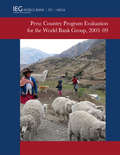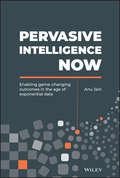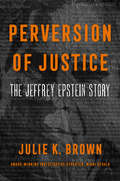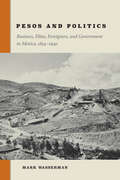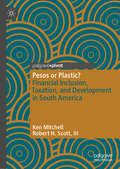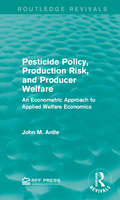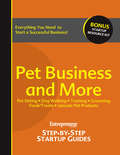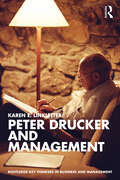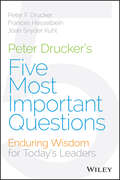- Table View
- List View
Persönlichkeitsdiagnostik: Persönlichkeit, Verhalten und Motivationsfaktoren als Schlüssel zum beruflichen Erfolg
by Dirk Thiemann Rainer SkazelDieses Buch zeigt mittels der AECdisc® Potenzialanalyse Schritt für Schritt auf, wie wir Stärken, Fähigkeiten und Motivationsfaktoren von Individuen erkennen, analysieren und nutzen können. Führungskräfte, Personalleiter und Unternehmer können mithilfe der Analyse die richtigen neuen Mitarbeitenden gewinnen und bestehende Kollegen fördern, sowie diese in gut funktionierenden Teams langfristig an das Unternehmen binden. Die Potenzialanalyse schickt die Anwender auf eine Reise zu sich selbst, auf der sie schrittweise erfahren, welche unbewussten Verhaltensmuster, Stärken und verbesserungsfähigen Kompetenzen sie haben.
Perturbation Methods in Credit Derivatives: Strategies for Efficient Risk Management (Wiley Finance)
by Colin TurfusStress-test financial models and price credit instruments with confidence and efficiency using the perturbation approach taught in this expert volume Perturbation Methods in Credit Derivatives: Strategies for Efficient Risk Management offers an incisive examination of a new approach to pricing credit-contingent financial instruments. Author and experienced financial engineer Dr. Colin Turfus has created an approach that allows model validators to perform rapid benchmarking of risk and pricing models while making the most efficient use possible of computing resources. The book provides innumerable benefits to a wide range of quantitative financial experts attempting to comply with increasingly burdensome regulatory stress-testing requirements, including: Replacing time-consuming Monte Carlo simulations with faster, simpler pricing algorithms for front-office quants Allowing CVA quants to quantify the impact of counterparty risk, including wrong-way correlation risk, more efficiently Developing more efficient algorithms for generating stress scenarios for market risk quants Obtaining more intuitive analytic pricing formulae which offer a clearer intuition of the important relationships among market parameters, modelling assumptions and trade/portfolio characteristics for traders The methods comprehensively taught in Perturbation Methods in Credit Derivatives also apply to CVA/DVA calculations and contingent credit default swap pricing.
Peru: Country Program Evaluation for the World Bank Group, 2003-2009
by World BankThis Peru Country Program Evaluation for the World Bank Group, 2003-2009 is part of IEG's country program evaluation series. To date, IEG's in-depth country evaluations have comprised IEG-WB Country Assistance Evaluations (CAEs) and IEG-IFC Country Impact Reviews (CIRs). Both the CAEs and CIRs have involved comprehensive evaluations of the respective institutions' activities in a country. In a pilot approach, this evaluation was prepared by a single IEG team that looked at development interventions across the three WBG institutions. The evaluation draws on WBG documents, external literature, and on interviews with government officials, representatives of the private sector and civil society, nongovernmental organizations, bilateral and multilateral development partners, and Bank, IFC, and MIGA staff in Washington and in Peru. An IEG mission visited Peru in September 2009. IEG also cooperated with the Evaluation Office of the Global Environment Facility that was conducting a parallel evaluation in Peru.
Peru: Economic Miracle or Just a Mirage
by Richard H.K. Vietor Fernando A. D'Alessio Ricardo M. PinoAfter years of rapid growth, Peru's economy had recently slowed. Mineral prices were down and the current President, Humala, had only a year remaining in office before the next election. And he could not run again. While the country had many strengths, especially in minerals, natural resources and tourism, infrastructural problems, corruption, drugs, and inequality continued to plague its growth. The next election would help determine Peru's future growth.
Peru: Request for Stand-By Arrangement--Staff Report; Staff Supplement; Staff Statement; Press Release on the Executive Board Discussion; and Statement by the Executive Director for Peru
by International Monetary FundA report from the International Monetary Fund.
Peru: Selected Issues (Imf Staff Country Reports #Country Report No. 14/22)
by International Monetary Fund. Western Hemisphere Dept.A report from the International Monetary Fund.
Peruvian Street Lives: Culture, Power, and Economy among Market Women of Cuzco (Interp Culture New Millennium)
by Linda J. SeligmannFor more than twenty years, Linda J. Seligmann walked the streets of Peru in city and countryside alike, talking to the women who work in the informal and open-air markets in Cuzco's Andean highlands. Her combination of ethnographic analysis, insightful and human vignettes, and superb photographs offers a humane yet incisive portrait of the women's lives against the backdrop of globalization and other powerful forces. In Peruvian Street Lives, Seligmann argues that the sometimes invisible and informal economic, social, and political networks market women establish may appear disorderly and chaotic, but in fact often keep dysfunctional economies and corrupt bureaucracies from utterly destroying the ability of citizens to survive from day to day. Seligmann asks why the constructive efforts of market women to make a living provoke such negative social perceptions from some members of Peruvian society, who see them as symbols and actual catalysts of social disorder. At the same time, Seligmann shows how market women eke out a living, combat discrimination, and transgress racial and gender ideologies within the rich and expressive cultural traditions they have developed.
Pervasive Information Systems (Advances In Management Information Systems Ser.)
by Panos E Kourouthanassis George M GiaglisToday's ubiquitous computing technology is imbedded in everyday objects from cars to clothes to shipping containers, whose location, context, and state can be monitored, instantly processed, and acted upon. This new volume in the "Advances in Management Information Systems" series provides an in-depth review of the state-of-the-art practices and research opportunities in a new era where information technology resides in physical space. Written for both scholars and practitioners, "Pervasive Information Systems" is organized into three sections, each investigating a distinct part of the subject. Part I focuses on the design challenges of Pervasive Information Systems (PS), and discusses issues relating to the coordination of PS through middleware structures as well as issues related to the efficient deployment of PS. Part II discusses the challenges and limitations of deploying pervasive technologies to support domestic, corporate, and public systems. Part III presents two emerging research fields of PS - design for aesthetics and PS evaluation.
Pervasive Intelligence Now: Enabling Game-Changing Outcomes in the Age of Exponential Data
by Anu JainThis book looks at strategies to help companies become more intelligent, connected, and agile. It discusses how companies can define and measure high-impact outcomes and use effectively analytics technology to achieve them. It also looks at the technology needed to implement the analytics necessary to achieve high-impact outcomes—from both analytics tool and technical infrastructure perspective. Also discussed are ancillary, but critical, topics such as data security and governance that may not traditionally be a part of analytics discussions but are essential in helping companies maintain a secure environment for their analytics and access the quality data they need to gain critical insights and drive better decision-making.
Pervasive Powers: The Politics of Corporate Authority (Routledge International Studies in Business History)
by Sara Angeli AguitonIn an era of systemic crisis and of global critiques of the unsustainable perpetuation of capitalism, Pervasive Powers: The Politics of Corporate Authority critically questions the conditions for the maintenance and expansion of corporate power. The book explores empirical case studies in the realms of finance, urban policies, automobile safety, environmental risk, agriculture, and food in western democracies. It renews understanding of the power of big business, focusing on how the study of temporalities, of multi-sited influence and of sociotechnical tools is crucial to an analysis of the evolution of corporate authority. Drawing on different literatures, ranging from research on business associations and global governance to that on the social production of ignorance or on corporate crime, this book aims at contributing to existing works on the capacity of corporations to rule the world. Unlike approaches focused on economic elites and on the political activities of firms, it goes beyond analysis of the power of corporations to influence policy-making to depict their unprecedented capacity to transform and shape the social world. Operating in numerous social spaces and mobilizing a wide range of strategies, corporate organizations have acquired the pervasive power to act far beyond mere spaces of regulation and government. Based on contributions from historians, science and technology studies scholars, sociologists and political scientists, this book will be of great interest to researchers, academics and students who wish to understand how corporations exert a pervasive influence on public policies, and to NGOs and regulatory agencies.
Perversion of Justice: The Jeffrey Epstein Story
by Julie K. BrownThe New York Times Bestseller“A gripping journalistic procedural… Spotlight meets Erin Brockovich.” —Michelle Goldberg, The New York Times“Julie K. Brown's important book offers not just a definitive account of the Epstein case, but a compelling window into her own experiences as a dogged reporter at a regional newspaper, facing off against powerful interests set against her reporting.” —Ronan Farrow, Pulitzer Prize-winning author of Catch and KillDauntless journalist Julie K. Brown recounts her uncompromising and risky investigation of Jeffrey Epstein's underage sex trafficking operation, and the explosive reporting for the Miami Herald that finally brought him to justice while exposing the powerful people and broken system that protected him.For many years, billionaire Jeffrey Epstein's penchant for teenage girls was an open secret in the high society of Palm Beach, Florida and Upper East Side, Manhattan. Charged in 2008 with soliciting prostitution from minors, Epstein was treated with unheard of leniency, dictating the terms of his non-prosecution. The media virtually ignored the failures of the criminal justice system, and Epstein's friends and business partners brushed the allegations aside. But when in 2017 the U.S Attorney who approved Epstein's plea deal, Alexander Acosta, was chosen by President Trump as Labor Secretary, reporter Julie K. Brown was compelled to ask questions.Despite her editor's skepticism that she could add a new dimension to a known story, Brown determined that her goal would be to track down the victims themselves. Poring over thousands of redacted court documents, traveling across the country and chasing down information in difficulty and sometimes dangerous circumstances, Brown tracked down dozens of Epstein's victims, now young women struggling to reclaim their lives after the trauma and shame they had endured.Brown's resulting three-part series in the Miami Herald was one of the most explosive news stories of the decade, revealing how Epstein ran a global sex trafficking pyramid scheme with impunity for years, targeting vulnerable teens, often from fractured homes and then turning them into recruiters. The outrage led to Epstein's arrest, the disappearance and eventual arrest of his closest accomplice Ghislaine Maxwell, and the resignation of Acosta. The financier's mysterious suicide in a New York City jail cell prompted wild speculation about the secrets he took to the grave-and whether his death was intentional or the result of foul play.Tracking Epstein’s evolution from a college dropout to one of the most successful financiers in the country—whose associates included Donald Trump, Prince Andrew, and Bill Clinton—Perversion of Justice builds on Brown's original award-winning series, showing the power of truth, the value of local reportage and the tenacity of one woman in the face of the deep-seated corruption of powerful men.
Perú Porvenir
by Pedro Pablo KuczynskiLa urgencia de contar con una política económica sensata para lograr crecimiento y así poder combatir y eventualmente eliminar la pobreza en el Perú, es el tema central alrededor del cual giran estos textos Con este libro, Pedro Pablo Kuczynski pone en la agenda de los peruanos la celebración del Bicentenario del Perú como república. No ofrece una fórmula ni una receta, sino un amplio análisis de la realidad nacional, sobre el rumbo económico del país y sobre la urgencia de erradicar la pobreza de su territorio. Se trata, ante todo, de una reflexión serena y a la vez entusiasta sobre el destino del Perú. Reseña: «De apellidos europeos y carrera global, sus inquietudes y desvelos -plasmados con lucidez en los artículos de este libro: Perú Porvenir- demuestran que PPK es alguien que sueña, siente y piensa en peruano». Felipe Ortiz de Zevallos
Pesos and Politics: Business, Elites, Foreigners, and Government in Mexico, 1854-1940
by Mark WassermanThe relationship between business and politics is crucial to understanding Mexican history, and Pesos and Politics explores this relationship from the mid-nineteenth century dictatorship of Porfirio Diaz through the Mexican Revolution (1876–1940). Historian Mark Wasserman argues that throughout this era, over the course of successive regimes, there was an evolving enterprise system that had to balance the interests of the Mexican national elite, state and local governments, large foreign corporations, and individual foreign entrepreneurs. During and after the Revolution these groups were joined by organized labor and organized peasants. Contrary to past assessments, Wasserman argues that no one of these groups was ever powerful enough to dominate another. Because Mexican governments and elites committed themselves to economic models that relied on foreign investment and technology, they had to reach a balance that simultaneously attracted foreign entrepreneurs, but did not allow them to become too powerful or too privileged. Concentrating on the three most important sectors of the Mexican economy: mining, agriculture, and railroads, and employing a series of case studies of the careers of prominent Mexican business people and the operations of large U.S.-owned ranching and mining companies, Wasserman effectively demonstrates that Mexicans in fact controlled their economy from the 1880s through 1940; foreigners did not exploit the country; and, Mexicans established, sometimes shakily, sometimes unplanned, a system of relations between foreigners, elite and government (and later unions and peasant organizations) that maintained checks and balances on all parties.
Pesos or Plastic?: Financial Inclusion, Taxation, and Development in South America
by Ken Mitchell Robert H. Scott, IIIThe book covers financial inclusion in the southern cone (Argentina, Brazil, and Chile) and its impact on public finance. Possible negative consequences of greater financial inclusion are identified, but the book argues potential benefits outweigh costs. Financial inclusion has many definitions, but in this book, we interpret it as bank account ownership and the use of banking services. Financial inclusion in this context proffers advantages in the area of tax collection, perhaps the southern cone’s gravest economic obstacle given its future debt servicing commitments and its socioeconomic development challenges.Households with a bank account – or, the bank participation rate – began increasing significantly around 2002, and this increase has coincided with an unexpected rise in tax collection (especially value-added taxes (VAT)) spanning periods of macroeconomic growth (2003-2009) and stagnation (2010-2015). Correlation does not imply causation, yet using empirical methods this book shows financial inclusion contributes to better tax collection by encouraging more formal market transactions via the use of bank-provided credit and debit cards. Consumption represents the largest component of most economies and consumption taxes contribute more to public revenue in the southern cone than other taxes, hence more formal consumption enhances overall tax collection.
Pesticide Policy, Production Risk, and Producer Welfare: An Econometric Approach to Applied Welfare Economics (Routledge Revivals)
by John M. AntleThe use of pesticides to control agricultural pests both benefits farm production and imposes health and environmental costs on producers and society. This title, first published in 1988, includes an application of the author’s methodology to tomato production, in which Antle illuminates the roles that alternative methods of pest management play in producer welfare. He also develops a more general empirical framework for studying producer welfare under uncertainty – a framework in which production risk, sequential decision making, and attitudes toward risk are integrated. This title will be of interest to students of environmental studies.
Pet Business and More
by Entrepreneur MagazineAmericans love to pamper their pets. It's estimated that we spent nearly $36 billion on our cats, dogs, birds, fish, horses and other pets last year alone! And that number is expected to grow, continuing the decade-long trend of increased spending on pets. This means if you love pets, there are plenty of opportunities for you to turn your passion into a profitable and rewarding business.Our guide gives you practical, real-world advice, tips and insider secrets for starting five of the most in-demand pet-product and pet-care services, including pet sitting/dog walking, dog training, pet grooming, pet-food/treat sales and upscale pet products.We walk you step-by-step through every aspect of setting up and maintaining a thriving business including:Getting fundingFinding suppliers and productsEquipping your businessAttracting--and keeping--customersPricing competitivelyTaking your business onlineKeeping recordsAnd much, much moreYou'll also hear from industry experts, as well as fellow entrepreneurs who've built successful operations and are eager to share what they've learned in the process.Startup costs are fairly low. You can operate most of these businesses out of your home -- two can even be strictly internet-based to really keep expenses low. And all of them can be launched and run profitably without employees. If you're fascinated by all things furred, feathered and finned, this is the guide for you. Order yours today.The First Three YearsIn addition to industry specific information, you'll also tap into Entrepreneur's more than 30 years of small business expertise via the 2nd section of the guide - Start Your Own Business. SYOB offers critical startup essentials and a current, comprehensive view of what it takes to survive the crucial first three years, giving your exactly what you need to survive and succeed. Plus, you'll get advice and insight from experts and practicing entrepreneurs, all offering common-sense approaches and solutions to a wide range of challenges. Pin point your target market Uncover creative financing for startup and growth Use online resources to streamline your business plan Learn the secrets of successful marketing Discover digital and social media tools and how to use them Take advantage of hundreds of resources Receive vital forms, worksheets and checklists From startup to retirement, millions of entrepreneurs and small business owners have trusted Entrepreneur to point them in the right direction. We'll teach you the secrets of the winners, and give you exactly what you need to lay the groundwork for success.BONUS: Entrepreneur's Startup Resource Kit!Every small business is unique. Therefore, it's essential to have tools that are customizable depending on your business's needs. That's why with Entrepreneur is also offering you access to our Startup Resource Kit. Get instant access to thousands of business letters, sales letters, sample documents and more - all at your fingertips!You'll find the following:The Small Business Legal ToolkitWhen your business dreams go from idea to reality, you're suddenly faced with laws and regulations governing nearly every move you make. Learn how to stay in compliance and protect your business from legal action. In this essential toolkit, you'll get answers to the "how do I get started?" questions every business owner faces along with a thorough understanding of the legal and tax requirements of your business.Sample Business Letters1000+ customizable business letters covering each type of written business communication you're likelyto encounter as you communicate with customers, suppliers, employees, and others. Plus a complete guide to business communication that covers every question you may have about developing your own business communication style.Sample Sales LettersThe experts at Entrepreneur have compliled more than 1000 of the most effective sales letters covering introductions, prospecting, setting up appointments, cover letters, proposal letters, the all-important follow-up letter and letters covering all aspects of sales oper...
Pete Carroll: Building A Winning Organization through Purpose, Caring, and Inclusion
by Monte Burke Ranjay Gulati Matthew D. BreitfelderPete Carroll, the head coach of the Seattle Seahawks, is the American football world's anomaly. His leadership style is the opposite of the traditional one, a more humanistic approach, based on developing and nurturing strong connections with his players on an interpersonal level and on celebrating, and not suppressing, their individuality. It is anchored by psychology and mindfulness, with Grit author Angela Duckworth noting that Carroll is tapping into something universal about human performance and potential. Carroll believes that to elevate your game you need to start with a strong sense of purpose that is anchored in a clear personal philosophy. As a leader he is committed to the idea that caring personally about each player and his unique needs, background and aspirations is fundamental to his success as a coach. His style is seen by some as overly positive, "touchy feely" and lacking the top-down edge expected of successful coaches. But what casual observers miss is the rigor, discipline, intense spirit of competition and a passion for winning that underpin his approach. His leadership has enabled a distinctive culture that has become a magnet for highly talented players, especially those who are known as gifted and value their individualism. His results provide clear evidence that his model works. Carroll is among the most successful football coaches of the last 50 years, achieving a remarkable level of consistently competing at the highest levels, including winning both a Super Bowl and multiple collegiate national titles. Carroll has influenced numerous championship-winning coaches in football and basketball, including the NBA's Golden State Warriors and the NCAA's LSU Tigers. And the increasing embrace of Carroll's leadership practices by CEO's including Microsoft's Satya Nadella demonstrate that his caring and humanistic form of leadership may help deliver exceptional results far beyond the football field.
Peter Browning and Continental White Cap (A)
by Mary Gentile Todd D. JickPresents a new divisional vice president's entry into a well-established and still successful manufacturing organization which is nevertheless facing an impending competitive crisis. Demonstrates his challenge and his efforts, under pressure from corporate headquarters, to convince his staff that the crisis is real and to make changes in the organization's family culture and practice, in order to better position them to face the onslaught of price wars and new technology. Concludes with several complex choices facing the new vice president as he considers whether or not to replace some key but problematic senior managers, and what strategy to adopt in his relations with the retired but still visible descendant of the firm's founder.
Peter Browning and Continental White Cap (B)
by Mary Gentile Todd D. JickDescribes the new divisional vice president's decisions and strategies in his first full year of management there. His influence style and tactics are demonstrated.
Peter Browning and Continental White Cap (C)
by Mary Gentile Todd D. JickPresents the results and impact of the new vice president's strategies in his first full year. Concludes with his reflections on the challenge he undertook.
Peter Drucker and Management (Routledge Key Thinkers in Business and Management)
by Karen E. LinkletterPeter Drucker is arguably the world’s most influential management writer, but his contributions as a social theorist and philosopher are also notable. This book presents Drucker as a key thinker, whose work encompasses ideas beyond management practice.Illuminating Drucker as a complex figure, this book highlights how his work draws upon, impacts, and intersects fields such as technology, sociology, philosophy, and theology. The book presents and contextualizes Drucker as an important historical figure, whose work resonates in a contemporary world where moderation between extremes is an essential ingredient in interpreting and navigating complex events and processes.Combining deep insights into Peter Drucker’s life and work, this unique book is valuable reading for scholars, students, and reflective practitioners of management as well as those with an interest in intellectual history more broadly.
Peter Drucker's Five Most Important Questions
by Peter F. Drucker Frances Hesselbein Joan Snyder KuhlEnduring Management Wisdom for Today's Leaders From Peter F. Drucker. Peter Drucker's Five Most Important Questions provides insightful guidance and stirring inspiration for today's leaders and entrepreneurs. By applying Drucker's leadership framework in the present context of today's leaders and those who lead with them, this book is an essential resource for people leading, managing and working in all three sectors--public, private and social. Readers will gain new perspectives and develop a solid foundation upon which to build a successful and bright future. They will learn how to focus on why they are doing what they're doing, how to do it better, and how to develop a realistic, motivational plan for achieving their goals. This brief, clear, and accessible guide -- peppered with commentary from distinguished management gurus, contemporary entrepreneurs and dynamic millennial leaders --will challenge readers and stimulate spirited discussion and action within any organization, inspiring positive change and new levels of excellence. In addition to contributions from Jim Collins, Marshall Goldsmith, and Judith Rodin, the book features new insights from some of today's most influential leaders in business (GE and Salesforce.com), academia (Harvard Business School and Northwestern University), social enterprise (Levo League, Pencils of Promise and Why Millennials Matter) and the military (United States Military Academy), who have been directly influenced by Drucker's theory of management.
Peter Green's First Day
by Laura L. Nash John B. Matthews Jr.Peter Green, a new salesperson for Scott Carpets, learns firsthand that his largest account has always been given a discount based on falsified information and expects the same preferred treatment to continue. Peter's boss condones the discount. Peter must decide whether to pursue the order on these conditions and how to handle his already shattered relationship with his boss.
Peter Guber: The "Me" vs. "We" Brand
by William Ellet Stephen A. Greyser Nelson GaytonWell-known film producer Peter Guber must decide whether to commit to a time-consuming personal project. He is about to sign a contract for a business book in which he will share what he has learned in his long career. At the same time, he is keenly aware of problems and uncertainties affecting Mandalay Entertainment, a privately-owned company in which he is principal. Mandalay produces movies and television content, owns minor league baseball teams, and is pushing into digital content. Mandalay is trying to reinvigorate its core movie and television businesses, maintain growth in the sports business, and be prepared for the opportunity to buy a major league professional sports franchise. Does Guber eliminate all personal projects and stay tightly focused on guiding his company? On the other hand, there may never be a good time to write a book. He also has to consider the potential impact of a book project on his personal brand and the Mandalay company brand.


